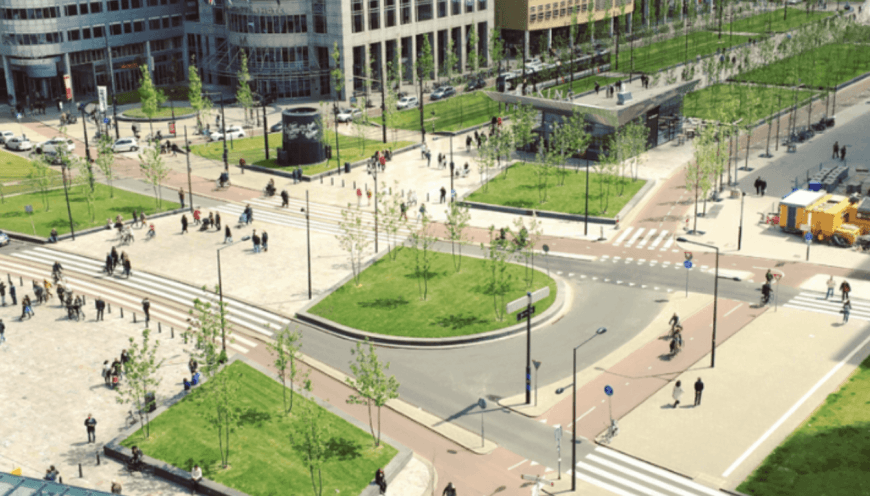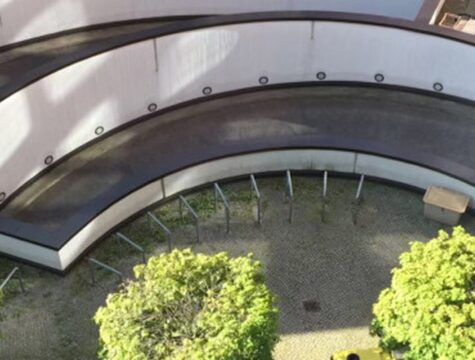Cities are at the center of the necessary change towards more sustainability and climate protection. Studies indicate that Circular Economy is a significant lever for reducing the climate impacts of our actions. Depending on the study, the manner of product manufacturing and usage influences 40% to as much as 80% of greenhouse gas emissions. As actors responsible for creating economic stability, secure jobs, favorable conditions for business, and above all, urban quality of life, cities play a crucial role in shaping and promoting sustainable production methods and consumption patterns. Through collaboration with businesses and the public, cities can significantly contribute to mitigating the climate impact of product manufacturing and usage, thereby ensuring long-term quality of life in urban areas.
How can Circular Economy support municipalities in achieving their climate protection goals? This potential was explored by the Circular City Challenge.
Two and a half years ago, when the Circular City Challenge was launched, awareness of the connection between Circular Economy and climate protection was not widespread. As part of this initiative, participating cities and municipalities were invited to articulate their specific challenges in the realm of climate protection. Simultaneously, businesses were given the opportunity to submit their solutions in the field of Circular Economy to foster fruitful exchanges among various stakeholders.
To effectively engage solution providers, the Circular City Challenge initiated a comprehensive campaign and began to build an extensive network of multipliers. The initiative received support at both national and international levels from Impact Hubs, business and innovation hubs, as well as the Ellen MacArthur Foundation. Concurrently, a communication campaign was launched, featuring a wealth of information and a public call for participation. Responses came from around the globe, with approximately 120 submitted solutions from Europe, the USA, and Asia. The representatives from the participating partner cities and municipalities came from various administrative levels, with some operating at the district level while others had a city-wide focus.
“There were three essential steps in this challenge. First, we identified the challenges in collaboration with the cities. In this year’s format, we worked together with municipal partners in workshops to develop eight focal themes—among them the built environment, mobility, industry, and waste management—that are significant for the cities. The second step involved a call to solution providers, while the third step focused on data preparation. In this phase, favorites were determined through a jury process in the individual areas. We organized a digital pitch day with about 40 of these companies, resulting in the identification of the 23 most promising solutions,” explains Dina Padalkina from Circular Berlin.
The implementation of a circular economy requires partnership-based cooperation, as it cannot be realized in isolation.
In many cities and municipalities, the availability of resources, particularly personnel, poses a challenge. Therefore, it is even more crucial to leverage existing formats and synergies and adapt them accordingly. To successfully implement Circular Economy at the local level, each municipality needs a central point of contact or a strategic alliance focused on the execution of this concept. It is essential to develop an understanding of how and where Circular Economy can actually be implemented. In this context, it is important to think and work across departments, especially since Circular Economy is often perceived as a niche topic primarily addressed by climate officers. An example of this is the topic of sustainability, which also represents a cross-cutting issue requiring close collaboration among various departments.
Many municipalities also face limited financial resources, which complicate the implementation of innovative projects. Tight budgets and a lack of funding for forward-looking initiatives necessitate creative financing models and careful project prioritization. Magdalena Schmittlein (Municipality of Zeuthen) emphasized the importance of courage and financial flexibility: “What we primarily need is courage and perseverance. We require free funds that are not tied to everyday purposes.”
The staffing situation also presents a problem: insufficient personnel leads to overload and delays efficient implementation. Here, skillful resource allocation and innovative approaches to enhance efficiency are required. Additionally, the limited authority of municipal partners, who often can only act as intermediaries, necessitates a high degree of diplomacy and persuasion to engage the necessary decision-makers for project realization. Furthermore, interdepartmental dependencies are a complex factor, as various departments with potentially differing interests must be coordinated. Florian Sorg, the coordinator for Circular Economy in Stuttgart, sees his role primarily in networking and coordination. He recognizes the necessity of activating other stakeholders for implementation—a challenge that exists both internally and externally. For the future, he considers the Circular City Challenge a valuable format for engaging in dialogue and discussing current issues.
The Circular City Challenge makes it clear that the path to urban climate neutrality is paved by innovative, circular approaches and that inter-municipal cooperation plays a decisive role in this.
The transformation process brings multifaceted challenges that need to be addressed. The Circular City Challenge aimed to raise awareness among urban actors about the significance of Circular Economy while simultaneously providing them with concrete, market-ready solutions that could assist in tackling current challenges. A particular focus was placed on how urban development can be advanced. The initiative’s leaders recognized that it is insufficient to merely pass on the 23 most promising solutions to municipal partners. Rather, it is crucial to identify the barriers that impede implementation. This realization represents an important lesson for future projects. One participant in the challenge succinctly stated: “Circular Economy is not a topic that can be managed alone—it requires partners.”
The Circular City Challenge has demonstrated that the journey towards urban Circular Economy, despite its complexity, holds great potential. It is vital to remain flexible and adaptable to successfully implement the identified solutions despite all obstacles. Only in this way can the cycle be closed and the goal of climate neutrality achieved. However, the challenges do not lie solely with the cities. Solution providers should also develop a deeper understanding of the specific needs of the cities and improve communication to clarify the role of municipal partners. It is also important that companies not only develop concepts but also present at least a minimal viable product (MVP) to convey their vision and the feasibility of the solution.
Local Circles are Valuable, even for the Local Economy
The initiative has established important connections between municipalities, solution providers, and other stakeholders, laying the groundwork for future collaborations. Within the framework of the Circular City Challenge, a local “Re:source Center” was established in Stuttgart, preparing products and components that have reached the end of their first usage phase for re-entry into the cycle. Another exciting project involves the dismantling of a stadium grandstand made of precast concrete elements. The vision is to integrate these elements as stairs along the Neckar River, where citizens can later relax. However, this project is still in its early stages, as it remains to be clarified which stakeholders and resources are needed. In Zeuthen (Brandenburg), a pilot phase was conducted to analyze building energy data, while in Berlin-Neukölln, collaboration with the Global Goals Directive was initiated. In Vienna, a workshop was held to implement a local reusable system for the gastronomy sector.
What does the future look like?
The valuable insights gained from the Circular Economy Challenge are now being utilized to explore new avenues for knowledge transfer. The previous experiences have been extremely enriching, and we are now in an exciting phase where we are contemplating how to effectively share our knowledge in the coming years. Instead of another challenge, we are focusing on building formats such as training sessions, informational events, and networking opportunities for cities. A central aspect of this is how municipal partners can act as networks or multipliers for solution providers.
Find more information on circular-city-challenge.com
Download the Circular City Challenge Guide Book here to realize your own challenge.




